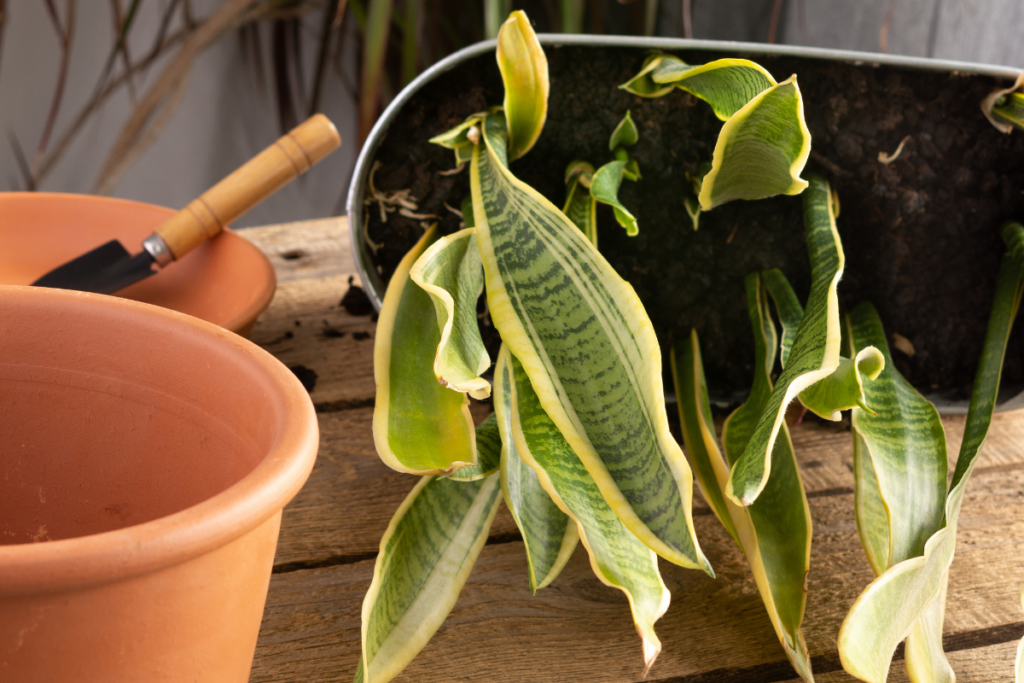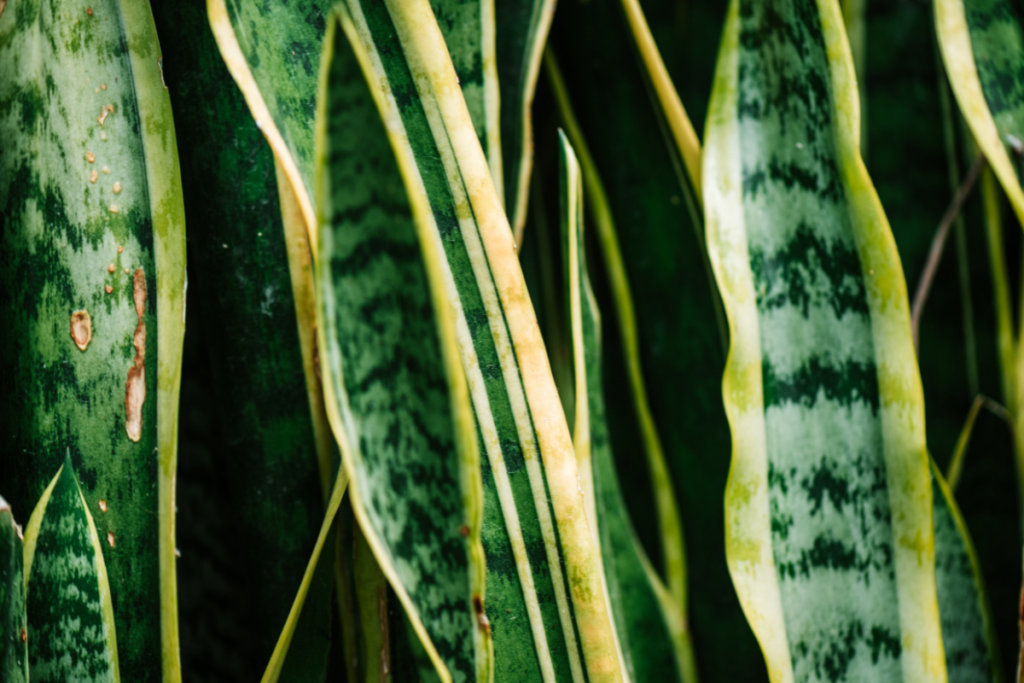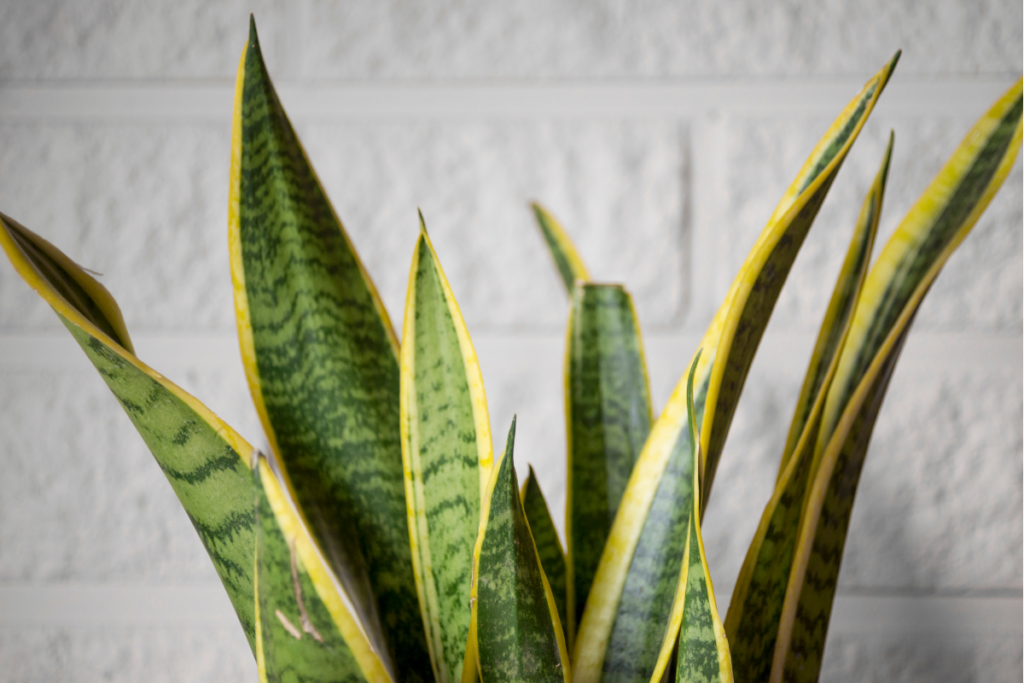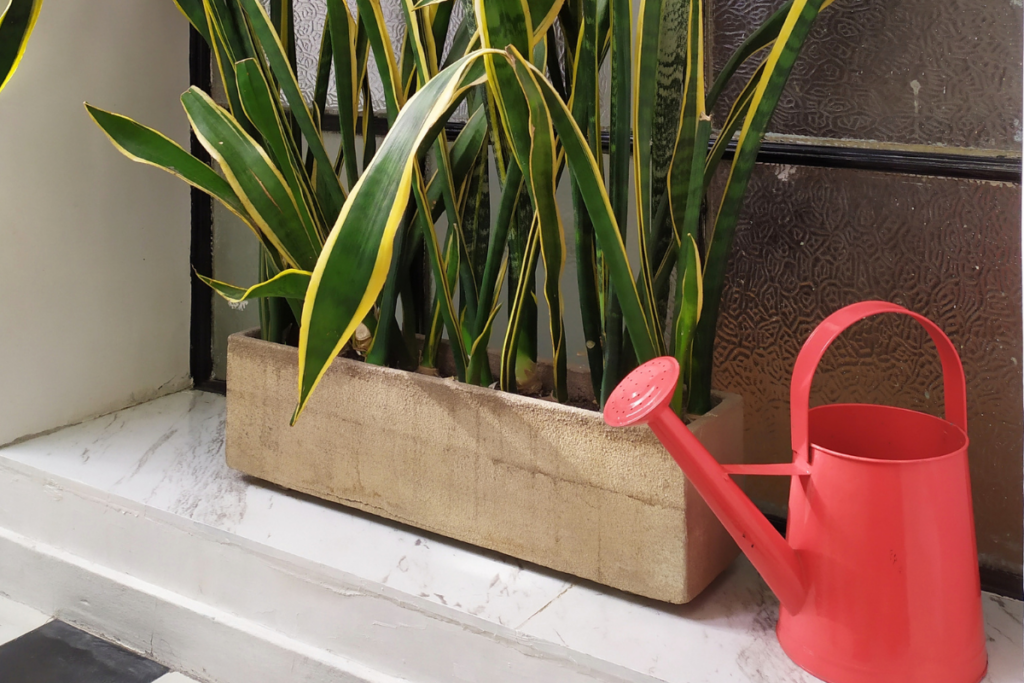Seeing your plant’s health decline is quite distressing. You are aware that your plant has a problem and that the issue needs to be fixed. However, it is sometimes difficult to determine why the plant is in such a state, and it is even more challenging to find the proper treatment to bring it back to life! In this article, you will learn how to revive a dying snake plant.

Owners of plants frequently face this problem, especially those who enjoy Sansevieria Plants or Snake Plants.
Although they have a unique beauty, Snake Plants are delicate enough to be vulnerable to numerous plant dangers. If they are not properly cared for, they are vulnerable to several plant issues and may even pass away.
The most frequent reason for snake plant death is either overwatering or underwatering. Even though a Snake Plant is highly resilient, the primary problem you’ll probably run into is that you’re giving it an excessive amount of water.
Additionally, look for additional problems, including sickness, poor growing circumstances, and pest infestations.
But don’t worry! In this article, we’ll go through every conceivable explanation for why your favorite Snake Plant may be dying. Of course, we’ll also demonstrate how to reverse the situation by offering you advice on how to raise the likelihood of surviving.
Signs To Look Out For To Know If Your Snake Plant Is Dying

Being able to acknowledge the presence of an issue in the first instance is a good place to start when trying to solve it.
If your entire plant displays any of the symptoms mentioned, it may be nearing the end of its life.
- You may have an overwatering problem if the Snake Plant leaves start to get floppy and soft. Among the most frequent issues that most plant enthusiasts deal with is this one.
- Others report that moist to wet growing soil and, occasionally, a smell of bog issuing from the growing mix are symptoms of this issue.
- The plant roots will also be harmed by overwatering. They will begin to mush up and change from white going to a distinct rusty brown hue. When this occurs, the situation becomes urgent.
- The leaves grow dry and crunchy. This typically begins at the tips of the leaves, going to the leaf margins. It’s possible that not enough water is to blame.
- If the Snake plant just doesn’t thrive and you later closely inspect it, you could notice little brown scabs which are apparent on the leaves. The scale bug is a pesky pest that sucks out plant sap.
- A small, white, fuzzy pest that you may come across is another annoyance. It likes to hide in leaf joints, going to other cracks that are unnoticeable by everyone save the alert watcher.
- The mealybug, another sucker insect, is present here as well. The two, among the most frequent pests that could endanger the health of your snake plant, are these two.
- Temperature regulation is a final issue that could be fatal. Despite having high tolerance to heat, your Snake Plants won’t like it if it gets too chilly.
- This is a potential culprit if the plant leaves begin to feel moist and mushy, and you are certain that you did not overwater your plants.
The majority of the issues mentioned will show themselves, particularly in the plant leaves. Only attentive inspection will allow you to respond correctly before the issue becomes too serious.
RELATED: Yellowing Snake Plants: How To Treat Them and More Information
How To Save A Dying Snake Plant?

As we’ve previously stated, there isn’t a single solution that can address every issue with your Snake Plants. However, if there was, we could spend less time trying to figure out what could have been wrong.
To give your Snake Plants the proper solutions, you must first correctly identify the root cause. We will assist you in restoring health to your dying Snake Plant. Let’s take an observation at the various causes and the corresponding solutions below.
1. Watering Issues
Your Snake Plant can be pretty fussy about how much water it receives. Therefore, too much or too enough water will undoubtedly result in a problem. If not fixed right away, underwatering and overwatering can cause plant death.
Here are two scenarios you should look for to identify the watering issue your Snake Plant is having:
Root Rot Due To Overwatering
Among the leading reasons for plant dying, root rot is something that all plant owners dread. A variety of factors may cause root rotting, but the most frequent one is the presence of excess water.
Long-term exposure to a wet environment will make it difficult for roots to breathe. The roots’ ability to effectively absorb nutrients and water for the Snake plant will be impaired in the absence of oxygen. If nothing is done, the plant will eventually wilt and die.
Root Rot Solution
First, let the soil dry out. Ensure the plant pot has adequate drainage and that the drainage holes are not obscured by anything. Only water when the soil is entirely dry. Keep in mind that the soil must be moist, but not soggy or saturated.
Change your potting mix and your container as needed. If your potting soil becomes overly compacted and soggy, throw it away and replace it with a new, airy mixture. Additionally, if the bottom of your pot lacks drainage holes, add more holes!
The most crucial thing to do is to adjust your watering routine schedule. Before watering, check the top two to three inches of plant soil. The basic rule is to forgo watering that day if the topsoil is still mostly wet. Otherwise, your Snake Plants require watering if the soil is already parched and dry.
Dehydration Due To Underwatering
Snake Plants do best in damp soil (but not waterlogged!). Even if a brief episode does not affect the plant, a prolonged one might seriously jeopardize its health.
Your plant cannot function when dehydrated, which causes it to wilt and wither. Your plant will undoubtedly perish if left untreated.
Dehydration Solution
Take a look at the growing mix. Check to see if the soil has the proper texture for your plant. If the soil is too loose and cannot retain moisture for an extended period, you must constantly water your plant. Then, alter the soil mix to one that is suitable, moisture-holding yet well-draining, or, even better, do both.
Water your plant as soon as possible. You’ll notice the plant looks better soon. Adapt your watering schedule to the plant’s needs and hydrate it againif so the top two to three inches of soil are completely dry.
2. Light Issues
Your plants may also suffer from inadequate or improper lighting conditions. The gorgeous foliage of these plants will undoubtedly burn if exposed to direct sunlight. On the other side, your plant won’t be able to photosynthesize appropriately under deficient light levels, preventing it from producing nourishment.
Serious health issues may result from prolonged overexposure to or underexposure to light. Because of this, it is preferable to place your plant where the lighting conditions are ideal for it. Remember that your tropical plants, like Snake Plants, want bright indirect light to grow.
Cut off and trim any damaged areas. Trim the sunburned portions of the leaves and prune the ones that have been seriously harmed using a clean cutting instrument for overexposed plants.
Light Solution
Put your plant in a window with an east or south orientation. These areas of your home provide your plant with the ideal lighting conditions it requires. For sun protection, make sure a sheer curtain or shade is present.
Utilize lights if you can. For example, an artificial light source can help you supplement the light your Snake Plant needs during the winter or if your home is darker than usual.
Every week, rotate the plant 90 degrees. Plants naturally curve in the direction of the light source. Weekly plant rotation will promote uniform, upright growth in your Snake Plants.
Read more about Snake Plants under direct lighting and outdoor gardening.
3. Temperature Issues
Your plant is more susceptible to illnesses when the temperature is outside the ideal range for Snake Plants, which is 60-75 degrees Fahrenheit.
Warm, humid conditions favor the growth of dangerous bacteria, fungi, and other diseases. On the other side, severely low temperatures might result in premature dormancy and make your plant prone to frostbites.
Temperature Issue Solution
Choose the best place for your plant. Keep the temperature of your plant above 50 degrees Fahrenheit.
Keep your plant out of drafts that are both hot and chilly. If your plant is indoors, keep it away from heaters, air conditioners, freezers, and other cold or hot breeze sources.
Look for ways to increase airflow. It can be accomplished by placing a fan nearby or opening windows so air can enter and exit.
Change where your plant is located during the winter. Your Snake Plant needs to be indoors or in a warmer spot during the colder days because it cannot tolerate the cold.
4. Humidity Issues
Your Snake Plant enjoys humidity in general because it is a tropical plant. Therefore, your plant should be kept at a humidity level of about 40-50%. If the leaves are kept somewhere with dry air, they will turn brown and curl.
Humidity Solutions
The leaves of your Snake Plant should be misted as needed. One approach to enhance the humidity surrounding your plants is by doing this. Once a week, you could spritz it with purified water. However, only do this when you observe dehydration problems on your plant, as excessive humidity can be detrimental.
5. Pest Issues
Snake Plants are pest attractors, especially in incredibly humid and mildly warm environments. They attract pests that could harm your plant, including spider mites, mealy bugs, aphids, scales, and leafhoppers.
These pests’ bites result in darker veins and brown patches on the leaves. In addition, these pests have the capacity to completely destroy your plant collection if left untreated because of their rapid growth and aggressive dissemination.
Pest Infestation Solutions
Clean up your plants. By first taking your Snake Plant to the sink and cleaning it down, you can get rid of the bugs manually. Not only the pests, but also their eggs, are flushed away by washing.
Spray horticultural oils, insecticides, and pesticides. Use organic chemicals to your advantage; they have been shown to be successful in keeping pests away. Spray your plant with any commercially available insecticides, pesticides, or oils once a week until pests are gone. An efficient natural pesticide is neem oil.
6. Disease Issues
Additionally, infections brought on by bacteria, fungi, parasites, and other pathogens may also be the cause of browning on your Snake Plant.
The most prevalent sign of a plant disease, along with brown patches on the diseased plant component, is leaf spotting.
Plant illnesses need to be addressed very away, much like a pest infestation. In addition to killing your plant, it can spread to other plants and cause havoc. The severity of the issue increases with the length of the treatment.
Disease Solutions
Place the ill Snake Plant in isolation and quarantine. By doing this, the illness won’t spread to other plants.
Remove all impacted components. Throw away any plant parts that exhibit disease symptoms. Don’t forget to properly dispose of the pieces and clean the tools used to prevent spreading.
Ensure adequate airflow. When the environment is damp and humid, microorganisms flourish and proliferate swiftly.
Use insecticides and fungicides. When necessary, heal your plant from disease-causing pathogens with pesticides or fungicides that are readily available on the market. Until the plant heals, spray them every week.
7. Transplanting Shock

Like all living things, plants occasionally struggle to adapt to their new surroundings. Before the plant fully acclimates to its new location, it can take several weeks. In the course of the process, stress indicators like leaf drying and yellow leaves are frequently seen.
Once your plant has fully adapted, it will resume its healthy size under the right environmental conditions. Always bear in mind all the prerequisites for a healthy Snake Plant.
8. Inefficient Drainage System
This is a problem that needs to be carefully considered with all indoor plants, not just the snake plant. A growth media can essentially suffocate the roots if it is not draining well, acting as a reservoir, both for the illness and other infections.
This is a pretty prevalent issue, which is utterly surprising given how simple to prevent it. There are some indications that the soil in your yard is not properly draining. It is nearly certainly a drainage problem if it seems wet or saturated.
A second indication is the presence of mold or slime that is forming on the surface. Finally, you may tell that the soil is wet if it smells similar to a swamp.
Inefficient Drainage Solutions
The first factor to look for when purchasing a new plant are drainage holes at the bottom of the pot. You should be able to insert your finger through the hole without difficulty.
Another approach to determine if the growing soil has effectively dried out with the Snake Plant is to feel the growing medium through the drainage hole. Simply having adequate drainage through the opening in your pot is insufficient. Additionally, the plant’s growing medium should be very well drained.
The simplest method to do is to buy soil that has been specifically formulated for cacti or succulents. The majority of garden centers carry this.
However, if your provider is unable to satisfy your needs, you can create your own well-draining mix by combining three equal parts of regular potting soil and two parts grit or perlite.
Typically, indoor plants are supported by a saucer. Placing the plant pot into its saucer before draining it is a typical drainage mistake.
As the plant saucer fills with water, further drainage is slowed. After watering, try to completely drain the soil; however, if you discover the saucer is still holding water, tip the saucer right away to avoid any potential issues.
9. Incorrect Soil pH Level
Some plants may have difficulties absorbing minerals and nutrients when the soil’s pH level is off. For instance, inadequate iron intake may be the cause of vein-to-vein yellowing on a snake plant’s leaves. However, it’s important to note that the Sansevieria Plant can tolerate a wide variety of pH values, from 4.5 up to 8.5.
The pH level should ideally be in the range of 5.5 to 7.5. It ought to fall within this range when utilizing specialized potting soil mix.
The pH usually becomes excessively acidic when an amount of peat moss is added, but since you don’t want excessive water retention and if you are trying for a cactus-like mix, this shouldn’t be a problem.
You can get a kit for soil testing and examine the levels if you’re worried that your plants’ issues are being caused by an inappropriate pH level.
RELATED: Watering Snake Plants: How Often To Water and More Helpful Tips
10. Dormancy Issues
Every plant experiences a latent phase during which its own metabolism slows, and its growth rate is significantly reduced. Your once gorgeous snake plant looks to be dying at the moment.
As are the cases with the Snake Plants, this typically occurs during the colder winter months. Therefore, expect your Snake Plants to gradually slow down in the northern hemisphere between the late part of October and midway of March.
Being informed of dormancy is crucial since, during this time, your Snake plant will need considerably no fertilizer and less water.
The same method of feeling the plant soil mix before adding more water should be followed. About half of the regular amount of water throughout the plant’s growing season should now be the case.
11. Rootbound Issues
A snake plant essentially becomes root bound when its roots entirely fill the pot it is put in. This may affect the soil’s capacity to retain nutrients and moisture. Slowly the indications of decaying Sansevieria plants will surface.
These plants don’t require frequent repotting. Even with very tight Snake Plant’s roots, they are content.
However, roots poking through the pot’s drainage holes or even over the pot’s brim, or the pot bulging when placed inside plastic containers, are indications that you need to repot the plant. Repotting into a larger pot is the only option for resolving this issue.
Repotting Solution
You should repot your plant into the next size container if it has been exhibiting indications of stress or the plant has outgrown the current one.
- Check the root for rot by tipping the Snake Plant out of the pot. You can trim back any roots that are rusty or brown until you can reach white, clean root material.
- Use proper potting mixes and plant your pot in its new, clean container.
- Do not feel compelled to water your plant right away. Allow the plant to settle in since the soil likely has enough moisture to endure for some days.
- Once the soil is dry, continue as before by feeling for damp soil and water.
It is crucial that you give your plant the best conditions possible at this point, especially if it’s recovering from nearly dying. Keep your plant in a strong but indirect light. A surplus of light could exacerbate stress at this vulnerable time. Please make sure the humidity is at its ideal level, and the temperature is not extremely low.
How about if your plant has a serious case of a lethal illness like root rotting? The only method to revive dying snake plant is through propagation.
How Do You Keep Your Snake Plant From Dying?

Plant issues are unavoidable, but you can take precautions to keep your plant from getting them frequently. Following these simple instructions will help your plant avoid problems and thrive:
- You can keep the soil equally moist by following a suitable watering schedule and using a well-draining potting mix.
- Maintain at least 60 degrees Fahrenheit in both the temperature and the humidity level.
- Give your plant the right amount of light.
Final Thoughts
Always keep in mind that problems arise when gardening or taking care of and maintaining healthy plants. There isn’t a perfect plant or gardener. Recognize that occasionally things just happen, and you must deal with them.
Please keep in mind to initially evaluate the current circumstance in the case of your dying Snake Plant. Only when you have determined the root of the issue can you properly treat and revive a dying Snake Plant. Any action you take otherwise will be pointless. Your plant will definitely live and thrive if you understand the fundamentals!
Please share any relevant experiences you have had with Snake Plants in the comment box below. We’d be thrilled to hear from you!
Editor’s Recommendations
How To Propagate A Snake Plant: What You Need To Know
Potting Snake Plants: The Best Pots For Growing Your Sansevierias
Snake Plant Problems: Common Sansevieria Problems and How To Fix Them







